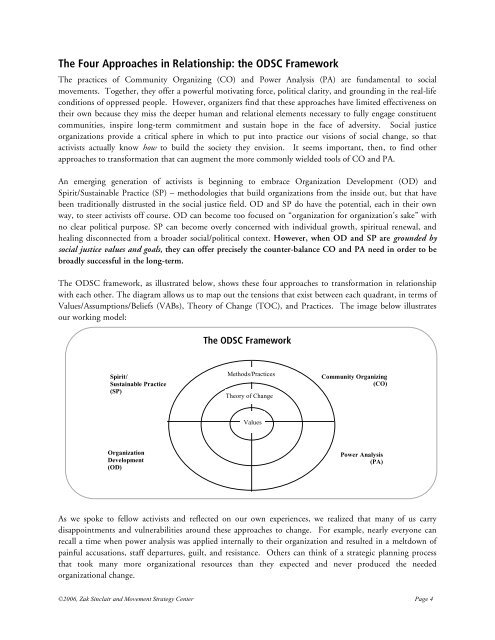The Four Approaches in Relationship: the ODSC FrameworkThe practices of Community Organizing (CO) and Power Analysis (PA) are fundamental to socialmovements. Together, they offer a powerful motivating <strong>for</strong>ce, political clarity, and grounding in the real-lifeconditions of oppressed people. However, organizers find that these approaches have limited effectiveness ontheir own because they miss the deeper human and relational elements necessary to fully engage constituentcommunities, inspire long-term commitment and sustain hope in the face of adversity. <strong>Social</strong> justiceorganizations provide a critical sphere in which to put into practice our visions of social change, so thatactivists actually know how to build the society they envision. It seems important, then, to find otherapproaches to trans<strong>for</strong>mation that can augment the more commonly wielded tools of CO and PA.An emerging generation of activists is beginning to embrace <strong>Organization</strong> <strong>Development</strong> (OD) andSpirit/Sustainable Practice (SP) – methodologies that build organizations from the inside out, but that havebeen traditionally distrusted in the social justice field. OD and SP do have the potential, each in their ownway, to steer activists off course. OD can become too focused on “organization <strong>for</strong> organization’s sake” withno clear political purpose. SP can become overly concerned with individual growth, spiritual renewal, andhealing disconnected from a broader social/political context. However, when OD and SP are grounded bysocial justice values and goals, they can offer precisely the counter-balance CO and PA need in order to bebroadly successful in the long-term.The ODSC framework, as illustrated below, shows these four approaches to trans<strong>for</strong>mation in relationshipwith each other. The diagram allows us to map out the tensions that exist between each quadrant, in terms ofValues/Assumptions/Beliefs (VABs), Theory of <strong>Change</strong> (TOC), and Practices. The image below illustratesour working model:The ODSC FrameworkSpirit/Sustainable Practice(SP)Methods/PracticesTheory of <strong>Change</strong>Community Organizing(CO)Values<strong>Organization</strong><strong>Development</strong>(OD)Power Analysis(PA)As we spoke to fellow activists and reflected on our own experiences, we realized that many of us carrydisappointments and vulnerabilities around these approaches to change. For example, nearly everyone canrecall a time when power analysis was applied internally to their organization and resulted in a meltdown ofpainful accusations, staff departures, guilt, and resistance. Others can think of a strategic planning processthat took many more organizational resources than they expected and never produced the neededorganizational change.©2006, Zak Sinclair and <strong>Movement</strong> <strong>Strategy</strong> Center Page 4
A group of six OD consultants who work with social justice organizations spent many months developing thismodel. We delved deeply into the historical origins, central values, theories of change, and practices of eachquadrant to identify both the gifts and the limitations of each approach. We found that each realmcontributes something valuable to individuals, groups, and organizations working <strong>for</strong> social justice. Whatfollows is a synthesis of what each quadrant has to offer to the process of movement-building and socialchange.oCommunity Organizing (CO) translates community concerns into collective action. This realmoffers community members the power and satisfaction of acting boldly on their beliefs, and presents aunique opportunity to be in direct relationship with others who share their values. It holds a distinctunderstanding of systemic injustice and the trans<strong>for</strong>mative power of righteous indignation.VABs, TOC, and Practices:Community Organizing values action, believes that building the collective power of those mostdirectly impacted by the problem will create change, and utilizes confrontational power-basedpractices in the public sphere (i.e., direct action), and more collective power-sharing practices in thecommunity sphere (i.e., one-on-ones, leadership development).oPower Analysis (PA) provides organizers with a framework <strong>for</strong> understanding the broader context inwhich we all live through the lens of power. It analyzes the social, economic, and political systemsthat shape our material, personal, cultural, and even spiritual realities. This framework creates acollective analysis of structural inequalities, and how they play out in our lives, with the desire tomotivate more strategic, collective action.VABs, TOC, and Practices:PA values theory and analysis, believes that change will come about when organizers and impactedcommunities understand exactly how structures of power and dynamic <strong>for</strong>ces work to oppress them,and utilizes the practices of grassroots political education and anti-oppression training.o<strong>Organization</strong> <strong>Development</strong> (OD) examines systemic change on the organizational level, andprovides tools and frameworks to improve an organization’s ability to meet its goals. It aims to helpthe group understand itself better and looks at the relationship of the individual to the group. ODoffers the potential to create organizational communities in the present that reflect our values,aspirations and visions <strong>for</strong> the future. This approach can help groups align their vision, values,structure, and purpose, and enact democratic principles of power sharing. Ultimately, OD honorsboth the inherent worth of each individual and the power of collective process to achieve its highestaspirations.VABs, TOC, and Practices:OD values the interpersonal realm and group process (i.e. believes that how work gets done is asimportant as what work gets done), believes that change occurs mainly by increasing a group’sawareness of and capacity to change their internal process and patterns, and practices organizationalassessment, visioning, planning, and group development.oSpirit/Sustainable Practice (SP) views self-knowledge, healing and cultural grounding as key totrans<strong>for</strong>mation, and offers tools to build authentic connection with oneself, others, and the outerworld. In the context of spirit and healing, one’s full humanity is recognized – emotions, intuition,©2006, Zak Sinclair and <strong>Movement</strong> <strong>Strategy</strong> Center Page 5


